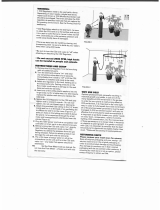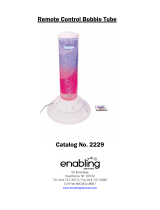
Vertex™ Rx-C 6D Calcium Reactor / Instruction Manual © Vertex Aquaristik ™GmbH, Deutschland 2014
Warranty, Service and Conditions:
Vertex™ Rx-C reactors carry a two-year limited manufacturer warranty. Parts and/ or components damaged due
to misuse, improper installation or normal wear & tear will not be covered under warranty. Vertex Aquaristik™
deserves the right to warranty products based upon inspection. If any damages occurred were deemed to be
caused due to any of the following reasons (but not limited to), they will not be covered under warranty:
Excessive Calcification
Improper assembly of the reactor
Improper assembly of the CO2 System
Custom modifications
Running the pump dry
Improper dialing of the Reactor
Use of impure or improper media
Procedures other than noted in this
guide.
Cutting the pump cable to use other plug
types
Physical damage or what caused by negligence
Improper electrical voltage and/ or frequency
Using parts and components other than supplied by Vertex and/ or utilized in the original design.
All warranty related issues should be handled at the point of purchase location by trained staff. Please
contact your dealer for warranty and/ or any other service/ maintenance the unit might require.
Pay attention to all the warnings and pointers noted in this guide and use common sense. To avoid
damage to property, livestock and/ or personal injury please follow all these instruction and/or consult
with a professional. Vertex Aquaristik™ will not be held liable for any damages the misuse,
modifications and/ or improper installation of this unit may cause.
Further to all the above, due to the fact that this device requires a pressurized gas tank to operate which
requires scheduled inspections, monitoring and adjustment only by authorized professionals; Vertex
Aquaristik™ cannot be held liable for any damages included but not limited to loss of livestock, damage
to property or loss of life caused by our product used in combination with a pressurized CO2 system. It
is humanly impossible to assess what has been the final cause of a disaster should one occur due to but
not limited to; explosions, leaks, fires, metal shrapnel, CO2 Poisoning, CO2 Burns or any type of CO2
exposure, asphyxiation, exposure to high Alkaline effluent or any other reason perceived or determined
to be caused by our product or the CO2 canister and its related devices used for CO2 injection.
If you cannot agree to the above terms and conditions, do not install or use this device, keep your
original packaging as well as proof of purchase and contact your dealer for a refund. Vertex Aquaristik™
will not issue refunds directly to the consumer and rather issues a credit to the retailer or the wholesaler
who has purchased the said product from Vertex Aquaristik™ for the amount the device was purchased
for. There will be no refund issued for used, installed or inferior than new condition products.




















